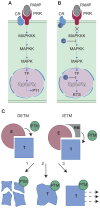Effector-triggered post-translational modifications and their role in suppression of plant immunity
- PMID: 22811685
- PMCID: PMC3397307
- DOI: 10.3389/fpls.2012.00160
Effector-triggered post-translational modifications and their role in suppression of plant immunity
Abstract
Plant-pathogen interactions feature complex signaling exchanges between host and microbes that ultimately determine association outcomes. Plants deploy pattern recognition receptors to perceive pathogen-associated molecular patterns, mount pattern-triggered immunity (PTI), and fend off potential pathogens. In recent years an increasing number of defense-signaling components have been identified along with a mechanistic understanding of their regulation during immune responses. Post-translational modifications (PTMs) are now thought to play a crucial role in regulating defense signaling. In a bid to suppress PTI and infect their host, pathogens have evolved large repertoires of effectors that trigger susceptibility and allow colonization of host tissues. While great progress has been made in elucidating defense-signaling networks in plants and the activities of effectors in immune suppression, a critical gap exists in our understanding of effector mechanism-of-action. Given the importance of PTMs in the regulation of defense signaling, we will explore the question: how do effectors modify the post-translational status of host proteins and thus interfere with host processes required for immunity? We will consider how emerging proteomics-based experimental strategies may help us answer this important question and ultimately open the pathogens' effector black box.
Keywords: PAMP-triggered immunity; direct effector-triggered modification; effector; effector-triggered susceptibility; indirect effector-triggered modification; post-translational modifications.
Figures

References
-
- Boller T., Felix G. (2009). A renaissance of elicitors: perception of microbe-associated molecular patterns and danger signals by pattern-recognition receptors. Annu. Rev. Plant Biol. 60 379–406 - PubMed
-
- Bos J. I. B., Armstrong M. R., Gilroy E. M., Boevink P. C., Hein I., Taylor R. M., Tian Z., Engelhardt S., Vetukuri R. R., Harrower B., Dixelius C., Bryan G., Sadanandom A., Whisson S. C., Kamoun S, Birch P. R. J. (2010). Phytophthora infestans effector AVR3a is essential for virulence and manipulates plant immunity by stabilizing host E3 ligase CMPG1. Proc. Natl. Acad. Sci. U.S.A. 107 9909–9914 - PMC - PubMed
LinkOut - more resources
Full Text Sources
Miscellaneous

